The Road Ahead
By Henry Petroski
Designers envisioning the future have not always been able to foretell advances in automotive and motorway technology.
Designers envisioning the future have not always been able to foretell advances in automotive and motorway technology.

DOI: 10.1511/2016.121.236
Norman Bel Geddes was born in 1893 about 40 miles west of Detroit, center of the nascent automobile industry. The unusual surname—Bel Geddes—was devised when Norman Melancton Geddes and Helen Belle Schneider married, and the portmanteau surname symbolized the joining of two creative minds. From an early age, when his mother took him to the opera, Bel Geddes had been fascinated by the stage, and his early success as a set designer led to his career in theatrical work.
Successively, the man whom the New York Times once described as “the Leonardo da Vinci of the 20th century” became an industrial designer, a popularizer of streamlining, and the creator of the 1939 New York World’s Fair General Motors “Highways and Horizons” exhibit known as “Futurama,” which he described as “a large-scale model representing almost every type of terrain in America and illustrating how a motorway system may be laid down over the entire country.”
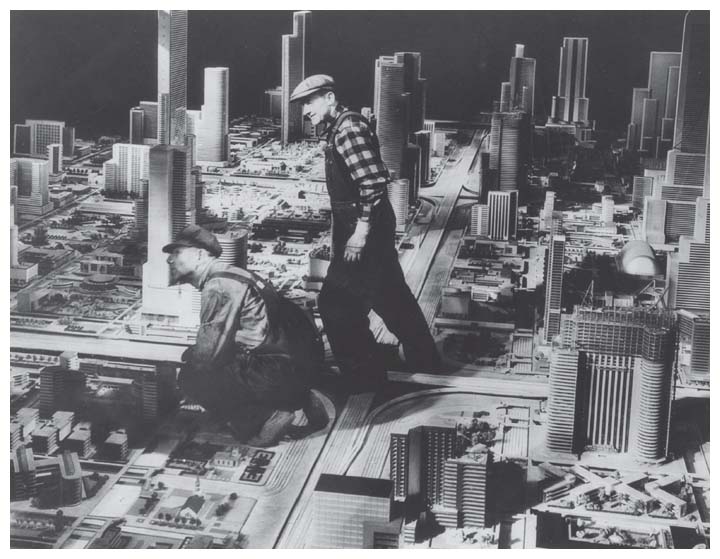
Image courtesy of the The New York Public Library Manuscripts and Archives Division.
Futurama was viewed by five million fairgoers, making it then “the most popular show of any Fair in history.” Visitors looked down upon the future from comfortable chairs that moved around the periphery of the model, which presented what the world of motorways might look like 20 years hence. Among the visions on display was an automated highway system in which automobiles essentially drove themselves, something that is being realized today in the form of Google’s and others’ autonomous vehicles. Bel Geddes attributed the success of the exhibit to the fact that “the people who stood in line ride in motor cars and therefore are harassed by the daily task” of driving, and “Futurama gave them a dramatic and graphic solution to a problem which they all faced.” (The exhibit was so successful that General Motors produced an updated “Futurama II” for the 1964 New York World’s Fair.)
Bel Geddes’ post-fair book, Magic Motorways, and the 1940 General Motors film To New Horizons contained numerous sanitized illustrations of not necessarily original concepts of what the future could look like. Prominent among them was a view of a “street intersection—city of tomorrow,” in which traffic appeared to be moving smoothly on one-way streets that were free of pedestrians, who were confined to elevated walkways or arcades highly reminiscent of those shown in a five-storied street concept proposed decades earlier, in a 1913 issue of Cassier’s Engineering Monthly. Bel Geddes’ book contained several versions of the elevated roadway concept, including one that added a raised deck above the crest of a power dam that already carried traffic across a river, as well as a double-deck bridge across a lake.
Ironically, for all the futuristic intersections and magical motorways illustrated in Bel Geddes’ book, the vast majority of depictions of vehicles were of a distinctly late 1930s vintage. It was as if Bel Geddes had his eyes so intently focused on the road that, in spite of his teardrop-shaped streamlining concepts, he did not think much about how the car in which he was riding might look in 1960. Or perhaps that was to be the purview of General Motors designers. After all, GM might not have wanted to reveal to the public or to the competition what it imagined automobiles 20 years hence would look like, would it? These days, perhaps we can have a clearer view of what’s possible now and in at least the near future.
The future promises to bring us smart cars riding along smart highways and over smart bridges. Even if the drivers are not smart and nod off at the wheel, the futuristic vehicles they will be driving will find their way home the way a family horse did in olden days. As Robert Frost’s little horse of yesteryear, in his 1916 poem “Stopping by Woods on a Snowy Evening,” thought it queer to be stopping by woods on a snowy evening, wondering if there were some mistake and giving its harness bells a shake in inquiry, so the automobile of tomorrow promises to question and warn us and even take control of matters when we try to do something foolish, such as approach at full speed a car stopped ahead; move into a passing lane when another vehicle is on our flank but not visible in the side-view mirror; drift across the lane or edge markings on the pavement; or drive past our exit.
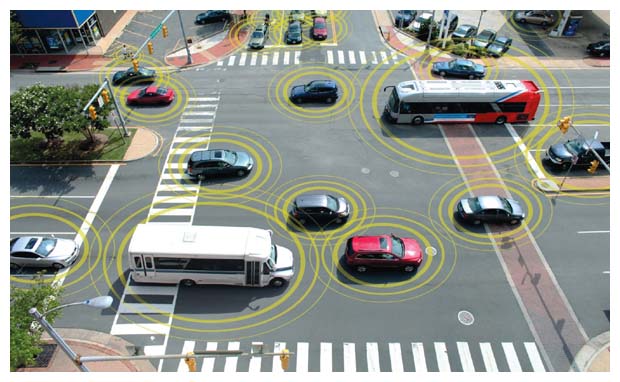
Image courtesy of the U.S. Department of Transportation.
Such driving aids are already available today, and the vehicle equipped with them communicates with the driver through a combination of aural, visual, and haptic prompts. Drivers become conditioned to and react to different numbers and tones of beeps, blinking and flashing lights and icons, or vibrating steering wheels and seats after a surprisingly short period of acclimation. Some of the systems are so sophisticated that they act when the driver does not, steering the car back into its lane or stopping the car automatically in an emergency. Some cars can park themselves, and a four-wheel-drive Tesla equipped with an autopilot will perform automatic lane changing when the driver signals his intention to do so. And, of course, in just about any car now, when we miss a turn, the GPS navigator we are using will inform us that it is recalculating our route or that we should make a legal U-turn as soon as conditions allow.
Vehicles also are equipped with devices that can check the pressure in all four tires simultaneously and display on the now-ubiquitous center screen the results along with the correct inflation pressures. Sophisticated cruise control systems can not only maintain a steady speed but also can maintain a fixed number of safe car lengths between our vehicle and the one in front of us. This kind of smart control is achieved with such smoothness of deceleration that the driver having set the cruising speed at 65 miles per hour will realize that his speed has been reduced to 55 only when every other car on the highway is passing both him and the slowpoke in front of him.
Drivers become conditioned to different beeps, lights, or vibrating prompts after a surprisingly short period of acclimation.
Even on the darkest evening of the year, the headlights of today’s cars brilliantly illuminate the dark and deep woods beside the road, some dimming themselves as traffic coming in the opposite direction warrants. When we wish to pull off the highway and onto a dirt road leading up to a farmhouse, the headlight beams will shift from pointing straight ahead to pointing left or right, depending on which way we are turning. Smart windshield wipers know to start working when a few drops of water strike the glass, and they adjust the speed of their sweep according to how heavily it is raining.
Experiencing such features in the cars of today, we might wonder what the future will bring. Will windshield wipers detect and clean off tree sap that streaks the glass? Will underinflated tires fill themselves even as we travel down the interstate? Will the illumination of the low-fuel warning icon trigger the GPS to identify the nearest service station selling our preferred brand of gasoline at the lowest local price and automatically direct us there? And if the distance to the pump is greater than the estimated miles of fuel left in the tank, will the car be slowed to the appropriate fuel-efficient speed to get us there before we run out of gas? These are the kinds of questions inventors and engineers pose to themselves on the way to improving present-day technology to make it future technology.
The features just described have more to do with vehicles than with the roads and bridges upon which they rely. Already it is commonplace to have detectors embedded in the pavement at intersections to tell traffic lights whether there is a vehicle waiting to make a left turn. If there is not, the left-turn arrow does not appear and traffic coming the other way is given the green light without delay. There are also smart open roads and bridges, pieces of smart infrastructure that in essence monitor themselves and alert engineers and others when they are in need of attention. A roadway can be embedded with sensors that detect snow and ice conditions, signaling when road crews should be dispatched. Bridges can be fitted not only with sensors but also with devices controlled by the sensors. Thus, when ice begins to develop on a bridge surface, the sensors that detect it can also trigger a system embedded in the curb or guardrail that sprays anti-icing solution over the pavement without human intervention.
Another use of such technology is to fit a bridge with devices that can detect when a beam or girder in the structure has developed a serious crack or corrosion. It is expensive to wire a large number of such devices to a data- collection computer that can communicate with, say, the state department of transportation, but if the devices are wireless, the installation can be done much more easily and efficiently.
One heavily used piece of infrastructure that would have benefited from detection devices is the Interstate 495 bridge over the Christina River in Wilmington, Delaware. In mid-2014, human inspectors found that a number of the piers supporting the approach viaduct were out of plumb and that the structure was leaning. The section of highway was closed while the problem was evaluated and, eventually, corrected. The viaduct, which ran over largely vacant industrial land, had been damaged when a 50,000-ton pile of dirt was illegally placed atop an area beside the bridge piers, causing the ground to shift and so damage the piers. Had they been fitted with sensitive wireless tilt meters akin to the kind that tell a smartphone or tablet which way is up, data indicating the abnormal condition might have been collected by a computer- and sensor-filled truck on a routine pass over the bridge. Earlier detection of the problem would likely have arrested the progressive damage and gotten the bridge back in service more quickly and at less expense.
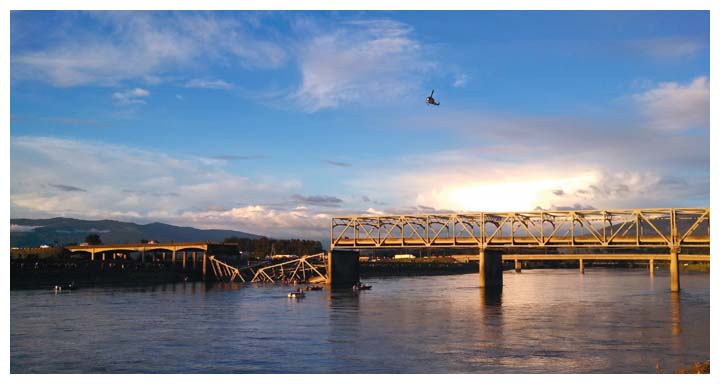
Martha T/Wikimedia Commons
In another case, in 2013, a bridge carrying Interstate 5 over the Skagit River in Washington State collapsed and fell into the water after an oversize truck hit parts of the overhead steel structure while passing through one of its truss spans. The 58-year-old bridge had been considered functionally obsolete, forcing traffic in the righthand lane to drive very close to the side of the structure, where the overhead braces curved downward and so reduced vertical clearance. There had been a history of tall vehicles striking these structural parts, but the bridge had survived prior impacts. In addition to this problem, the Skagit River Bridge was also classified as fracture-critical, making it like the interstate bridge in Minneapolis that had collapsed six years earlier, claiming 13 lives. No one died in the Skagit River Bridge collapse, but that was only a matter of luck.
Outfitting a bridge like the one over the Skagit River with sensors that detect a too-high oncoming vehicle would be easy to do. We already are familiar with devices that measure a vehicle’s speed by radar and display it on a sign beside the highway, thereby providing a warning to the driver to slow down. The augmented cruise control systems that keep a car a safe distance from the one in front of it use lasers and a computer to maintain a specified separation. Imagine a smart bridge with low clearance fitted with a similar device that could also communicate with an approaching tall but smart truck and slow it down to a stop before it impacted the bridge. That kind of wireless connection between bridge structure and vehicle could obviously prevent collapses and deaths. In time, it is likely to be a common reality.
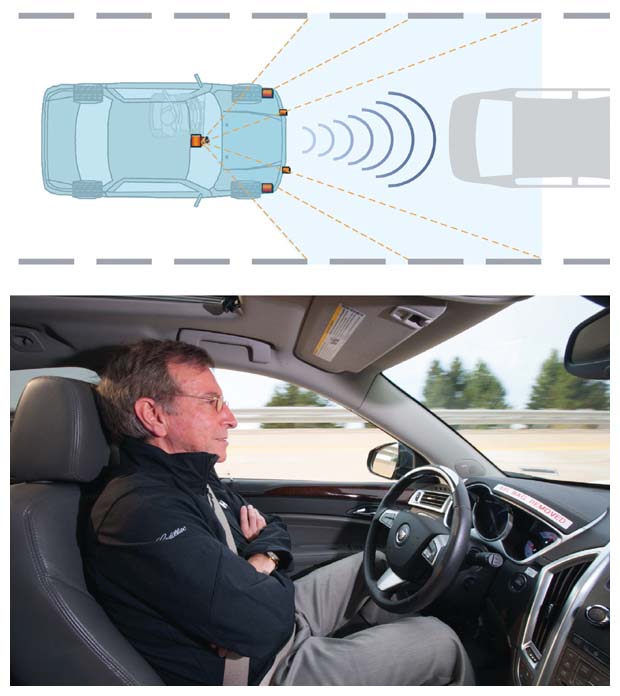
Images courtesy of GM.
Engineers are currently working on highway-vehicle systems that maintain a constant wireless connection among vehicles within a few hundred yards of one another traveling along the same stretch of highway. In such a system, two cars not visible to each other— either because there is congested traffic between them or the one ahead is rounding a blind curve—would be able to maintain contact. If the leading car has to stop suddenly, it would send a signal to the following car to apply its brakes also—and do it automatically.
Other so-called connected-vehicle technology could lead to the elimination of stop, yield, and other traffic signs. If all vehicles in the vicinity of an upcoming intersection were part of the wireless network, the computer in a car approaching the intersection could know whether there would be cross traffic. If so, the driver would be alerted to approach with caution or stop, and perhaps even have a bright electronic stop sign displayed on a navigation screen, if not as a hologram directly in the driver’s line of sight. If the intersection is anticipated to be clear, no warning would appear and the car would not even have to slow down. If all vehicles were part of such a system, traffic signs and lights could be eliminated entirely, thereby unburdening a transportation department of the need to purchase, install, and maintain such things. Furthermore, a highway without physical signs would be a less visually cluttered and hence a less distracting and more attractive and environmentally friendly road.
In the summer of 2014 the U.S. Department of Transportation announced its plan to require in the not-too-distant future the installation of vehicle-to- vehicle communication technology in all cars and trucks, new and old. Fitting a vehicle with a transmitter is projected to add about $350 to the cost of a new car in 2020; an existing car could be retrofitted with an equivalent device. Engineering research teams connected with universities, government laboratories, and the automotive industry are already testing the technology. As part of a program at the Michigan Transportation Research Institute in Ann Arbor, volunteers are driving almost 3,000 transmitter-equipped vehicles in actual traffic conditions.
Completely driverless cars are already a reality, though so far only as prototype vehicles. The development of such vehicles has been promoted for years by the U.S. Department of Defense, which through its Defense Advanced Research Projects Agency has for some years been sponsoring driverless-car challenges, offering prizes as high as $2 million for unmanned vehicles successfully negotiating urban and battlefield courses. Building on the successes of such programs, Google has been working on the development of driverless automobiles since 2009, and in the subsequent five years such vehicles drove themselves autonomously for more than 700,000 miles on public roads.
The automotive industry has also been actively developing its own autonomous technology. An Audi Q5 outfitted with a computer system processing data from onboard instruments including cameras, radar, and laser sensors in early 2015 completed a 3,400-mile trip from San Francisco to New York City, during which it behaved as an autonomous vehicle and steered itself 99 percent of the time. It was only in very complicated traffic situations such as construction zones that a human driver had to take over the wheel. Tesla Motors had plans to offer its Model S electric-powered sedan in a self-steering version in the summer of 2015, and Elon Musk, chief executive officer of Tesla, promised a fully autonomous vehicle by about 2020. General Motors is expected to introduce in 2017 technology in its Cadillac that will allow no-hands highway driving. The configuration of cars will naturally evolve with the use of such technology, and in time we can expect front seats to swivel around so that, if they wish, everyone in the vehicle can play card and board games, converse face-to-face, or catch up on email, send text messages, and otherwise immerse themselves in antisocial media.
Even when a vehicle’s occupants do not have their eyes on the road, they can help inspect and maintain it by being “data donors.” This is a concept introduced by New Urban Mechanics, a group dedicated to “an approach to civic innovation focused on delivering transformative city services to residents.” In 2010, the Mayor’s Office of New Urban Mechanics was formed in Boston, later joined by an analogous city agency in Philadelphia, each serving as an “innovation incubator” by “building partnerships between internal agencies and outside entrepreneurs to pilot projects that address resident needs.” Specific projects ranged from improved trash cans to high-tech smartphone apps.
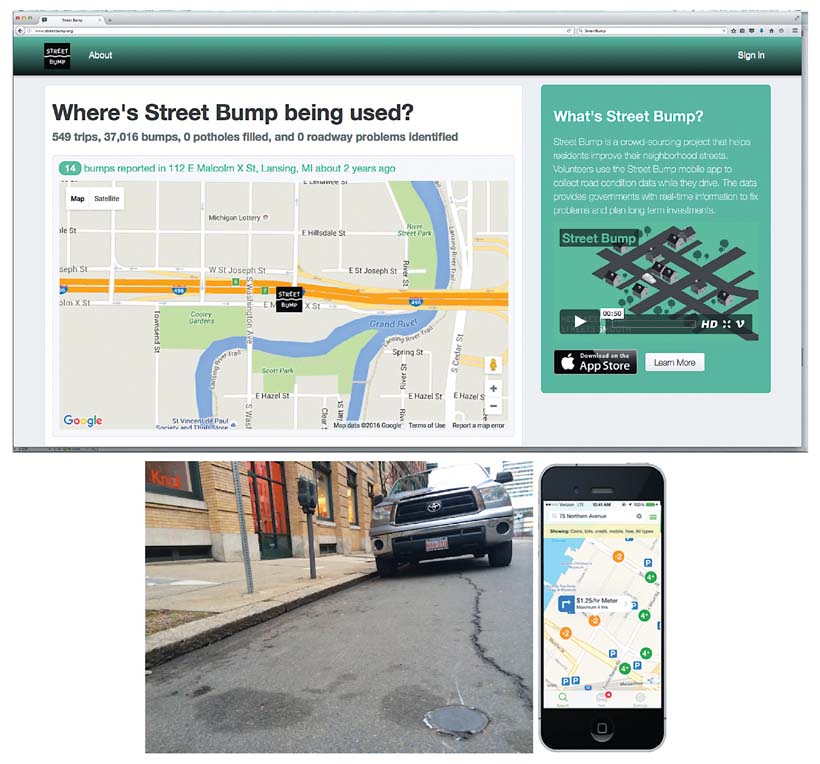
Images courtesy of New Urban Mechanics and the City of Boston.
Among the apps is Street Bump, which tracks an automobile’s ride over Boston streets. After the free app has been activated, the smartphone can be placed on a car’s dashboard to monitor the ride. The accelerometer in the phone detects bumps, and software distinguishes a bump due to hitting a pothole from one due to riding over a manhole or a speed bump. Where the vehicle does go over a pothole, the detected movement is paired via GPS with the location, and the data are sent—this is the data donation—to the appropriate city department that monitors the condition of the streets. When a pothole is identified, a road crew is sent to fill it. Engineers at Northeastern University have taken the concept a bit further with their Versatile Onboard Traffic Embedded Roaming Sensors, a mouthful no doubt forced to yield the acronym VOTERS. Vehicles driving a lot of city streets each day are outfitted with a variety of sensors that measure such things as tire sound, pavement surface defects, and subsurface delamination—data that when properly interpreted provide information on precursors to potholes. Suspect conditions can be monitored and repairs done when there are signs of a pothole beginning to form.
Cracks in a mix of asphalt concrete and short steel-wool fibers can be healed by subjecting the pavement material to microwaves.
Potholes themselves may be a thing of the past if researchers succeed in developing self-healing asphalt. One of the most prominent of these researchers is Erik Schlangen, a professor of civil engineering at Delft University of Technology in the Netherlands and leader of a group doing research in experimental micromechanics. By adding short steel-wool fibers into a mix of asphalt concrete, cracks that develop in the pavement material can be healed when it is subjected to microwaves. Schlangen has demonstrated the process in a six-and-one-half-minute TED talk, in which he breaks a small beam made of asphalt in two, places the two halves together in a microwave oven, and by the end of his talk removes a rejoined bar. His hope is to develop an industrial-scale microwave device that can be transported in a highway vehicle and perform the same kind of healing by induction.
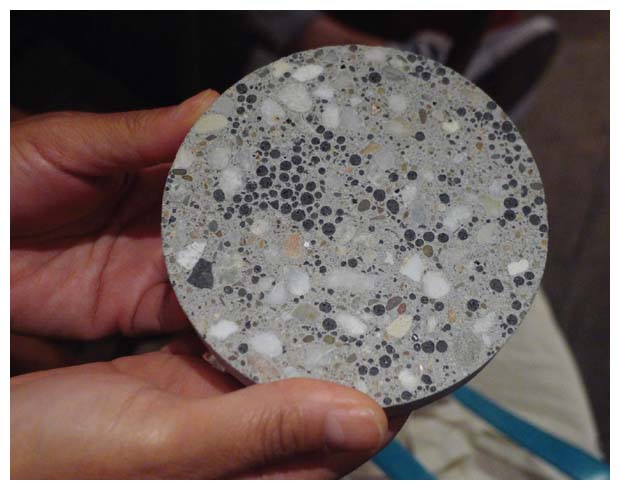
Photograph courtesy of TU Delft.
Self-healing concrete pavement made from Portland cement is also on the horizon. It can be made by incorporating into the concrete mix tiny capsules containing dormant bacteria capable of producing limestone when activated. This will happen when the concrete develops a crack that causes the encapsulated bacteria to be released and that allows water to reach the bacteria, thus enlivening them to do their work. Once activated, the bacteria consume a starchy substance that was incorporated into the concrete mix and excrete calcium carbonate, which is essentially limestone, thus plugging the crack and forestalling further damage. Structures formed of such concrete have recovered as much as 90 percent of their uncracked strength.
The roads of the future promise to be smooth and quiet, as will be the ride in all-electric vehicles that occupants will no doubt take for granted. The experience, however, may not be quite the same as Norman Bel Geddes laid out in the General Motors Futurama exhibit and in his book, Magic Motorways. It is likely to be far superior.
This article is excerpted and adapted from The Road Taken: The History and Future of America’s Infrastructure with permission from Bloomsbury Press.
Click "American Scientist" to access home page
American Scientist Comments and Discussion
To discuss our articles or comment on them, please share them and tag American Scientist on social media platforms. Here are links to our profiles on Twitter, Facebook, and LinkedIn.
If we re-share your post, we will moderate comments/discussion following our comments policy.